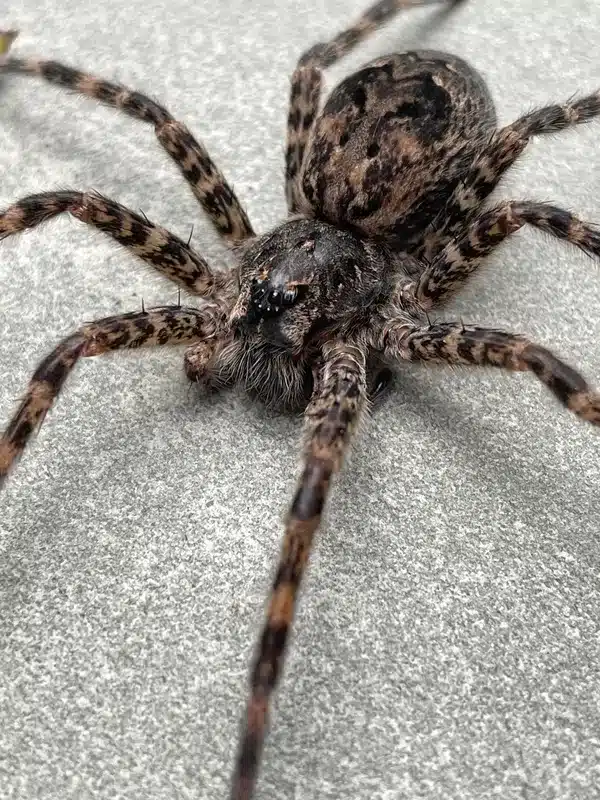When homeowners in Virginia and Maryland spot large spiders around their property, they often wonder what type they’re dealing with. Two of the most commonly confused species are fishing spiders and wolf spiders. While both can look intimidating due to their size, understanding the key differences between these spiders helps with proper identification and appropriate response.
In my years working pest control throughout Northern Virginia and Maryland, I’ve encountered both species regularly. Fishing spiders versus wolf spiders is one of the most frequent identification questions I get from customers, especially those living near water features or wooded areas like Mt. Vernon.
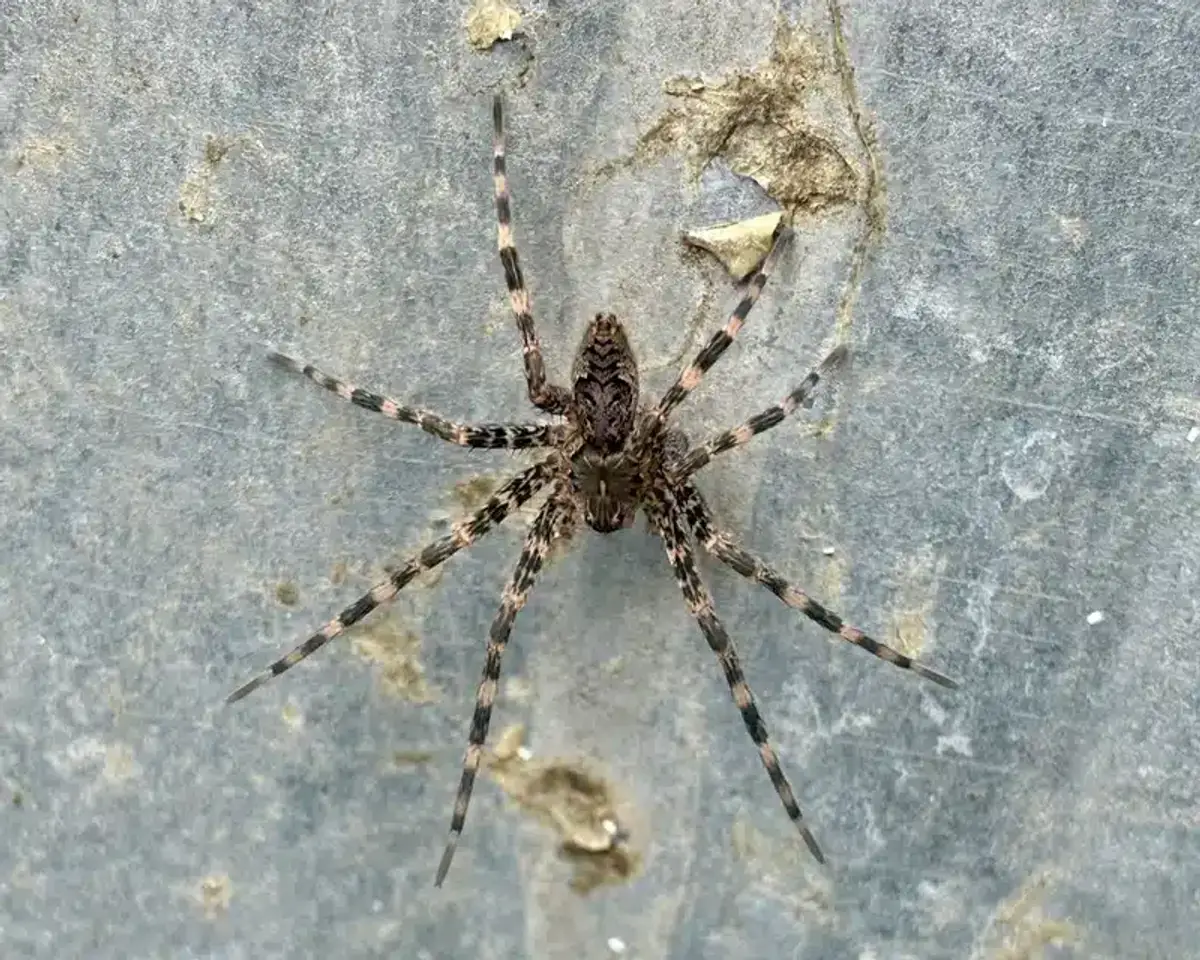
Size Differences Between Fishing Spiders and Wolf Spiders
The size comparison between fishing spider vs wolf spider reveals some interesting patterns. Fishing spiders typically measure 15-26 mm in body length, with females reaching impressive leg spans of 2-4 inches. The largest specimens, particularly the Dark Fishing Spider, can exceed 3 inches across when fully extended.
Wolf spiders range from 6-25 mm in body length with leg spans of 1-3 inches. However, the Carolina wolf spider, our region’s largest wolf spider species, can reach similar sizes to fishing spiders. Females measure 22-35 mm in body length with approximately 3-inch spans.
The key difference isn’t necessarily overall size, but rather body proportions. Fishing spiders have longer legs relative to their body mass, giving them a more elongated appearance compared to the more robust build of wolf spiders.
Physical Identification Features
Eye Arrangement Patterns
The most reliable way to distinguish between these species is examining their eye arrangements. Wolf spiders have eight eyes with distinctive large “headlight” eyes that reflect strongly when you shine a flashlight on them at night.
Fishing spiders also have eight eyes, but they’re arranged in two slightly curved rows. Their posterior median eyes are only mildly enlarged, lacking the distinctive “headlight” appearance of wolf spiders.
What does the science say?
According to Virginia Tech Extension research, wolf spiders have eight eyes arranged in three distinct rows - four small anterior eyes, two large median eyes, and two medium posterior eyes. This specific arrangement with enlarged median eyes creates the characteristic “headlight” reflection that makes wolf spider identification easier in low-light conditions.
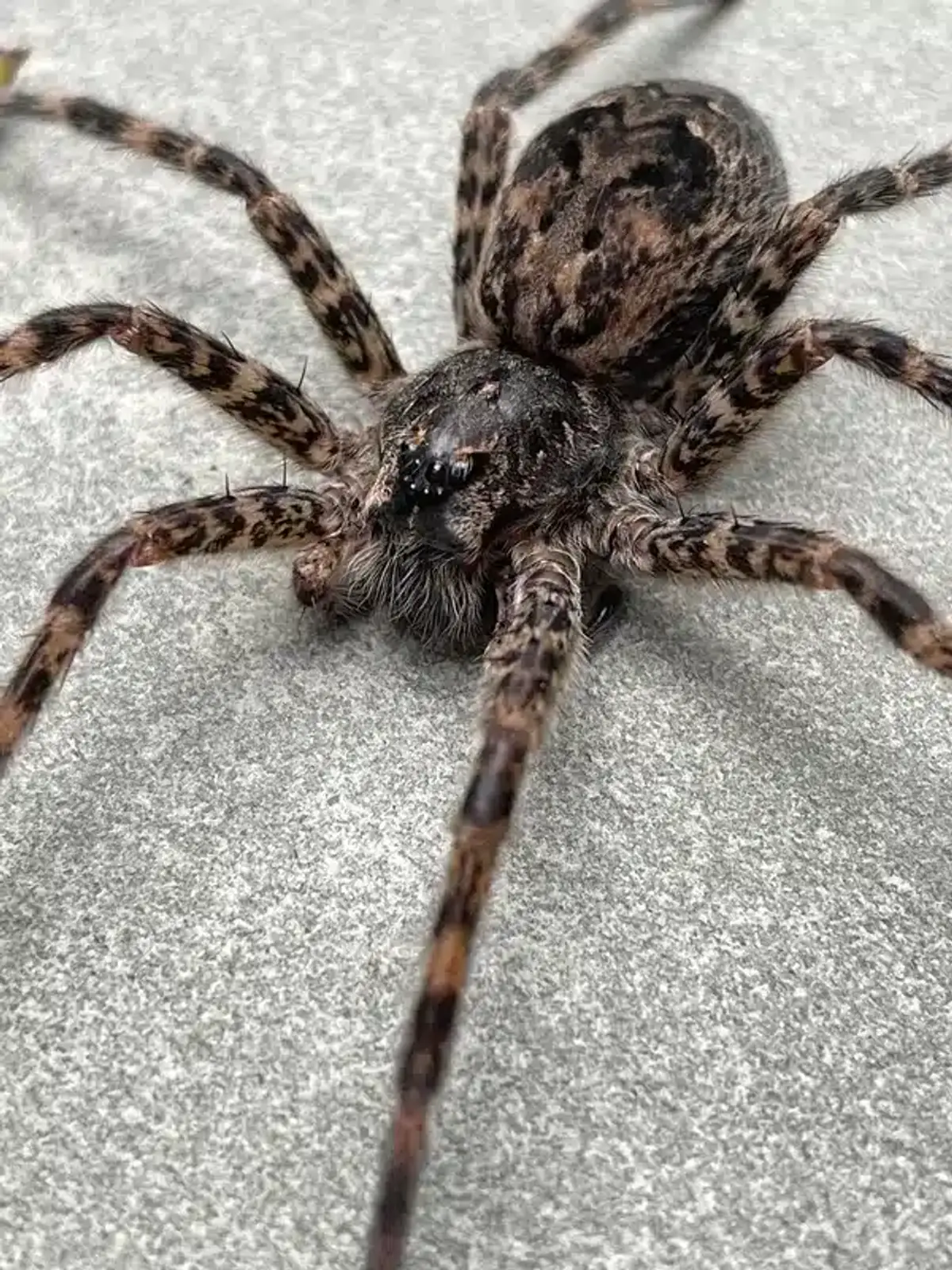
Body Patterns and Coloration
Fishing spiders usually display pale lateral stripes on both their carapace and abdomen, along with distinctly banded legs. Their bodies appear flattened, which helps them make contact with water surfaces.
Wolf spiders show more variation in their patterns, ranging from uniform earth tones to bold stripes and chevron patterns. Their bodies are more robust and slightly arched compared to the flatter profile of fishing spiders.
Habitat Preferences: Water vs Land
Fishing Spider Environments
As their name suggests, fishing spiders prefer semi-aquatic environments. You’ll find them around pond margins, lake shores, slow-moving streams, marshes, and boat docks. In Virginia and Maryland, they’re particularly common near the Chesapeake Bay and its tributaries.
Interestingly, Dark Fishing Spider females will venture into shaded woodlots and outbuildings, which is where homeowners sometimes encounter them indoors. During my work in areas with high moisture and tree coverage, I’ve spotted fishing spiders around properties with water features or those located near creeks.
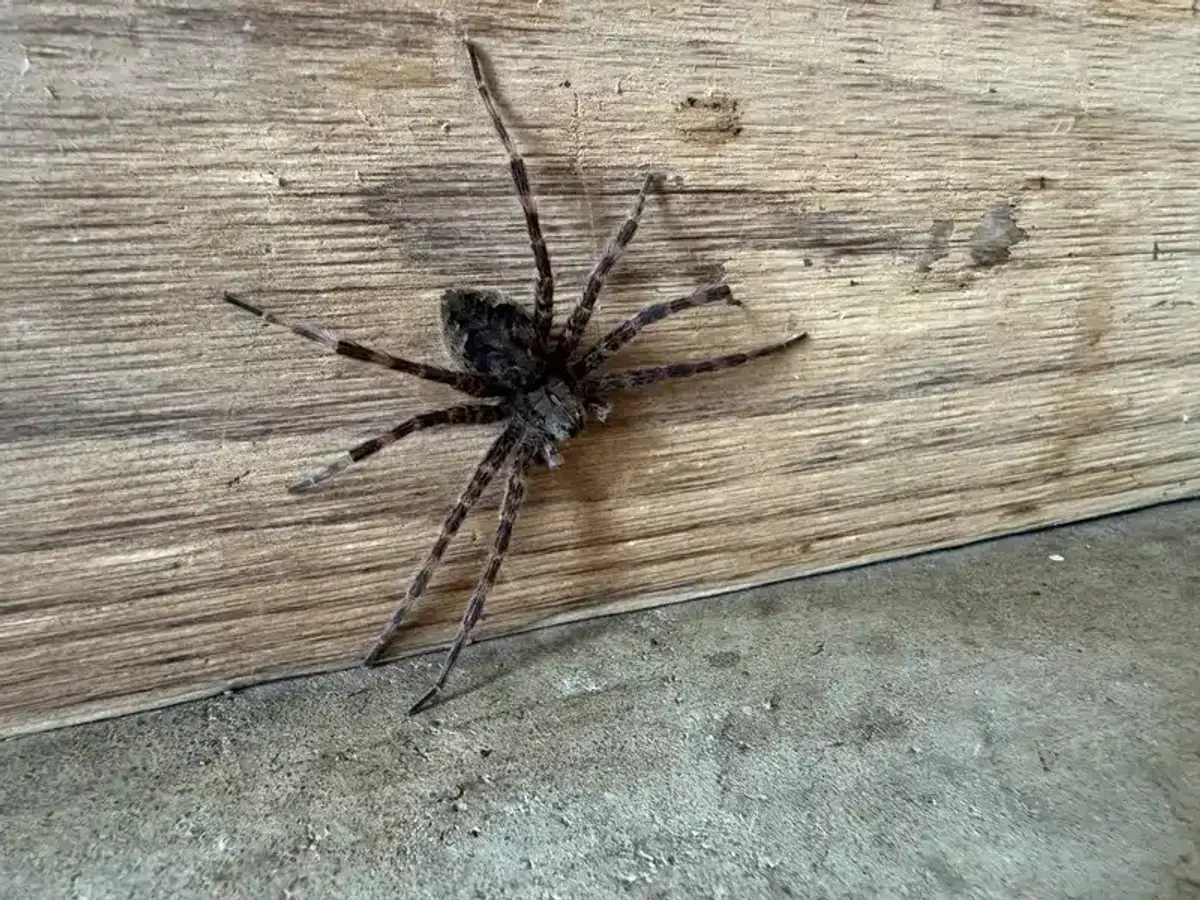
Wolf Spider Territory
Wolf spiders are strictly terrestrial, preferring leaf litter, lawns, crop fields, and sandy areas. They’re much more likely to wander into homes, especially basements and garages during autumn when seeking shelter for winter.
In my experience treating homes throughout Northern Virginia and Maryland, wolf spiders are significantly more common indoors than fishing spiders. They often appear on basement floors or under outdoor lighting where flying insects congregate.
| Fishing Spiders | Wolf Spiders | |
|---|---|---|
| Primary Environment | Water sources | Terrestrial areas |
| Common Locations | Ponds, streams, docks | Lawns, leaf litter, fields |
| Indoor Frequency | Rare (moisture issues) | Common (fall/winter) |
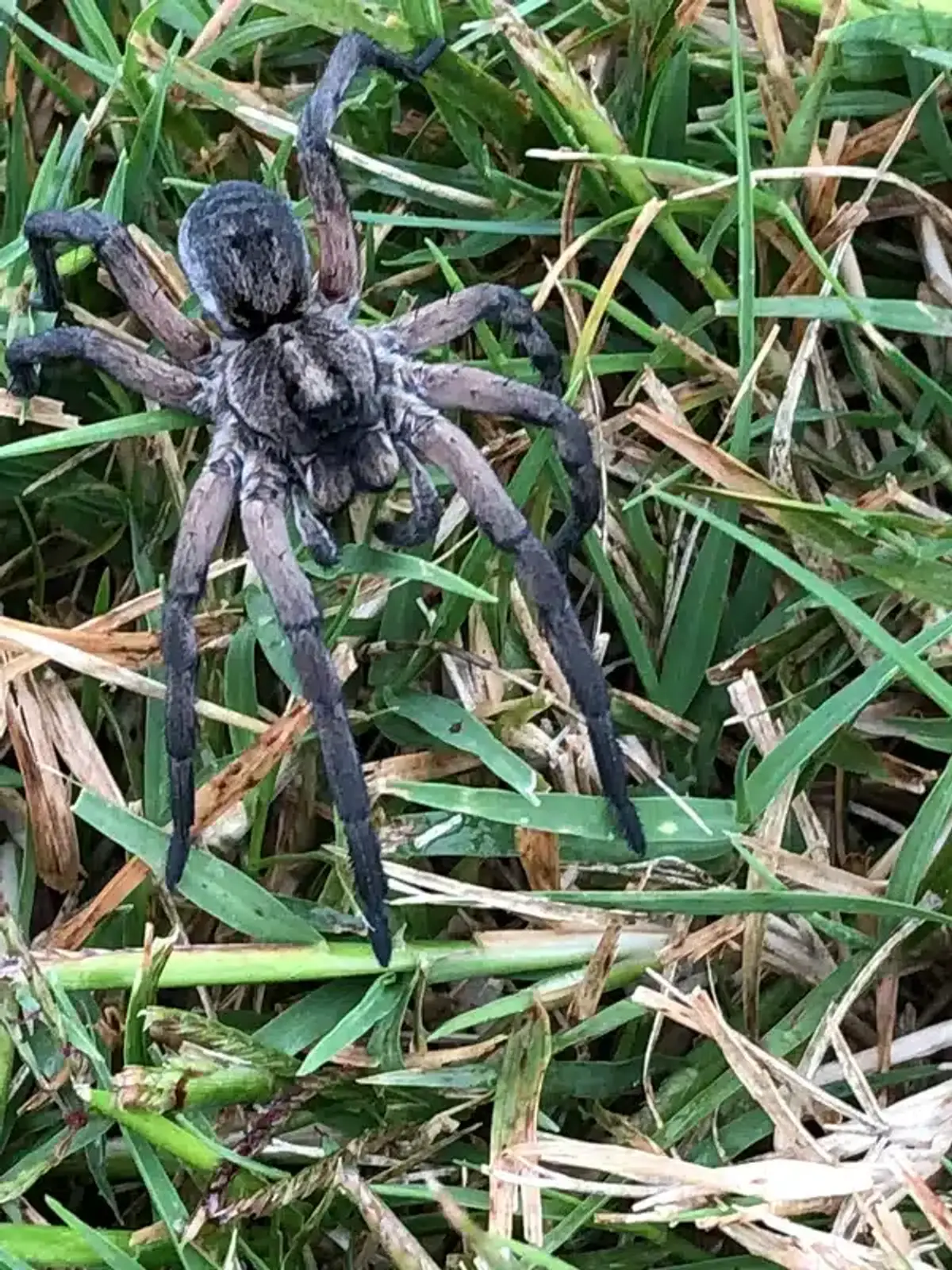
Hunting Behaviors and Movement
Fishing Spider Techniques
Fishing spiders are remarkable aquatic hunters with specialized techniques for water surface movement and underwater hunting.
Their hunting strategy involves anchoring their rear legs to vegetation while resting their front legs on the water surface. They detect prey through water vibrations and can dive 15-20 centimeters underwater, staying submerged for up to 30 minutes using trapped air bubbles.
What does the science say?
According to Spider Bytes research, fishing spiders can row, gallop, or “sail” across water surfaces using hydrophobic hairs and specialized leg movements that achieve speeds over 0.2 meters per second. Their ability to stay underwater for up to 30 minutes is made possible by trapped air bubbles that act as a temporary oxygen supply during hunting dives.
Wolf Spider Strategies
Wolf spiders are cursorial hunters, meaning they chase down their prey on land. They rely on excellent vision, vibration-sensing leg hairs, and quick bursts of speed to catch insects. Some species, like the Carolina wolf spider, prefer to sit at burrow entrances and ambush passing prey.
When I’m helping homeowners identify spiders, movement patterns often provide immediate clues. If you see a spider running quickly across the ground or lawn at night, it’s likely a wolf spider. Fishing spiders move differently and rarely venture far from water sources.
Diet and Ecological Benefits
Both spider types provide valuable pest control services, though they target different prey categories. Fishing spiders feed on aquatic insects, terrestrial insects that fall on water, tadpoles, and even small fish up to five times their own body weight.
Wolf spiders are generalist predators that consume ants, grasshoppers, crickets, caterpillars, and other spiders. They’re particularly valuable in agricultural settings and home landscapes because they help control pest insects naturally.
Rather than being pests themselves, both species should be considered beneficial. In my pest control work, I often explain to customers that these spiders are actually helping reduce populations of more problematic insects around their properties.
Reproductive Behavior and Life Cycles
The maternal care behaviors of fishing spider vs wolf spider species offer another identification clue. Both carry egg sacs and care for their young, but in distinctly different ways.

Wolf spider females attach their egg sacs to their spinnerets and carry them everywhere. After hatching, the spiderlings climb onto their mother’s abdomen and ride there for about a week before dispersing. This piggyback behavior is unique to wolf spiders.
Fishing spider females carry their egg sacs in their chelicerae (mouthparts), then construct a “nursery web” among plants near water for the protected hatching of 600-1,000+ eggs. This nursery web behavior distinguishes them from other spider families.
Bite Risks and Medical Significance
Neither fishing spiders nor wolf spiders pose significant medical risks to humans in Virginia and Maryland. Both species bite only when defensive pressure occurs, such as being accidentally pinned or improperly handled.
Envenomation from either species resembles a bee sting - causing transient pain, redness, and mild swelling. Serious effects are limited to rare allergic responses in sensitive individuals.
During my years of pest control work, I’ve never encountered a case where either species caused significant medical issues for homeowners. The key is simply avoiding direct contact and allowing these beneficial predators to do their job controlling other insects.
Seasonal Activity Patterns
Understanding when you’re most likely to encounter each species helps with identification. Adult fishing spiders peak during late spring through summer (May-September), with egg sacs most commonly observed in June and July.
Wolf spiders can be encountered year-round outdoors, but adults become most conspicuous during late summer and fall. This is when many species wander or enter buildings before winter frost arrives.
In my experience treating properties throughout the region, I encounter wolf spiders indoors most frequently during autumn months when they’re seeking overwintering sites. Fishing spiders rarely venture indoors unless there’s significant moisture infiltration near water sources.
Professional Spider Management
When dealing with either fishing spiders or wolf spiders around homes, the approach focuses on habitat modification rather than broad chemical treatments. Our method involves identifying factors that attract these spiders and addressing root causes.
Essential Spider Management Steps
- Identify the Species: Use eye arrangement and habitat location to distinguish between fishing and wolf spiders before treatment
- Address Root Causes: Remove attractants like excessive moisture, bright lighting, and insect prey sources
- Focus on Entry Points: Seal gaps around foundations, doors, and windows where wolf spiders commonly enter
- Monitor Results: Track spider activity levels after treatment to ensure effectiveness and prevent re-infestation

Common attractants include bright exterior lights that draw flying insects (spider prey), moisture problems, and wood rot that provides shelter. We advise customers on reducing these factors while applying targeted treatments to high-activity areas.
For webbing spiders, we remove current webs using a webster tool and apply non-repellent treatments along foundations. Spider control requires ongoing monitoring because these beneficial predators will return if conditions remain favorable.
Prevention and Exclusion Methods
Preventing spider encounters involves both structural modifications and environmental management. For wolf spiders, focus on entry point sealing using door sweeps, window screens, and foundation crack repair.
Managing fishing spider populations requires addressing moisture issues around homes. Check for leaking gutters, standing water, and overly damp basements or crawl spaces that might attract them away from their preferred aquatic habitats.
Exterior lighting modifications help with both species. Using less attractive yellow or sodium lights instead of bright white lights reduces the flying insects that spiders hunt. Additionally, closing window blinds at night prevents interior lights from attracting insects to your home’s exterior.
Common Misidentifications
Several factors contribute to confusion between fishing spider vs wolf spider identification. Size and brown coloration often lead to misidentification of both species as brown recluses, though true brown recluse spiders are essentially absent from most of Virginia and Maryland.
Nursery-web spiders (Pisaurina mira) share similar eye patterns with fishing spiders but are smaller and strictly terrestrial. Large funnel weaver spiders have visible spinnerets that appear as rear “tails,” distinguishing them from both fishing and wolf spiders.
When assisting homeowners with identification, I often recommend photographing the spider if possible and noting the location where it was found. Spider identification becomes much easier when you consider habitat context alongside physical features.
Regional Considerations for Virginia and Maryland
The mid-Atlantic region’s diverse habitats support multiple species of both fishing and wolf spiders. Maryland’s extensive waterways provide ideal conditions for fishing spiders, particularly around the Chesapeake Bay and its tributaries.
Northern Virginia’s mix of suburban development and wooded areas creates perfect wolf spider habitat. Areas like Spotsylvania County, with its rapid growth and ecosystem disturbance, often see increased spider activity as development displaces natural habitats.
Both species play important ecological roles in our region’s pest management. Rather than viewing them as problems, homeowners should recognize their value in controlling mosquitoes, flies, and other nuisance insects naturally.
If you’re dealing with spider concerns around your Virginia or Maryland home, professional identification and targeted management can help address the issue while preserving these beneficial predators. Our registered technicians understand the differences between fishing spider vs wolf spider species and can develop appropriate treatment strategies for your specific situation.
Contact us at 703-683-2000 or email info@bettertermite.com for expert spider identification and management solutions tailored to your property’s unique needs.
Frequently Asked Questions
How can I tell the difference between a fishing spider and wolf spider?
+
The easiest way to distinguish between fishing spider vs wolf spider is examining their eye arrangement and habitat. Wolf spiders have large "headlight" eyes that reflect strongly at night and are found on land. Fishing spiders have smaller, less prominent eyes and are typically found near water sources like ponds or streams.
Are fishing spiders or wolf spiders dangerous to humans?
+
Neither fishing spiders nor wolf spiders pose significant danger to humans. Both species bite only when threatened, and their venom effects are similar to bee stings - causing temporary pain, redness, and mild swelling. Serious reactions are extremely rare and limited to individuals with specific allergies.
Which spider is larger - fishing spider or wolf spider?
+
Fishing spiders are generally larger overall, with leg spans reaching 2-4 inches compared to wolf spiders' 1-3 inch spans. However, the largest wolf spider species in our region, the Carolina wolf spider, can approach similar sizes to fishing spiders. The main difference is that fishing spiders have longer legs relative to their body size.
Do fishing spiders come inside homes like wolf spiders?
+
Wolf spiders are much more likely to enter homes, especially basements and garages during fall and winter. Fishing spiders rarely venture indoors unless there are significant moisture issues or water infiltration problems. When they do appear inside, it's usually in damp areas like basements near water sources.
What attracts fishing spiders vs wolf spiders to my property?
+
Fishing spiders are attracted to properties with water features, moisture problems, and aquatic insect populations. Wolf spiders are drawn to areas with abundant ground-dwelling insects, outdoor lighting that attracts prey, and suitable shelter like leaf litter or mulch beds.
Can fishing spiders actually walk on water?
+
Yes, fishing spiders can walk, run, and even "sail" across water surfaces using specialized hydrophobic hairs and leg movements. They can achieve impressive speeds over 0.2 meters per second on water and can even dive underwater for up to 30 minutes when hunting prey.
How do I prevent wolf spiders and fishing spiders around my home?
+
Prevention strategies differ for each species. For wolf spiders, focus on sealing entry points, reducing exterior lighting, and eliminating ground-level shelter. For fishing spiders, address moisture issues, fix water leaks, and maintain proper drainage around your property. Both benefit from general pest control that reduces their insect prey.
When are fishing spiders and wolf spiders most active in Virginia and Maryland?
+
Fishing spiders are most active during late spring through summer (May-September), with peak activity in June and July. Wolf spiders can be encountered year-round but are most noticeable during late summer and fall when they seek overwintering sites and may enter buildings.
With five years of hands-on experience in the pest control industry, George Schulz is a registered technician with the Virginia Pest Management Association and a proud third-generation professional in a family business that’s been protecting homes for over 57 years. He manages and trains a team of service pros while also leading internal research efforts—recently spearheading a deep-dive review of thousands of documents on pest control materials to hand-pick the most kid and pet friendly, most effective solutions tailored specifically for homes in the DC metro area.
